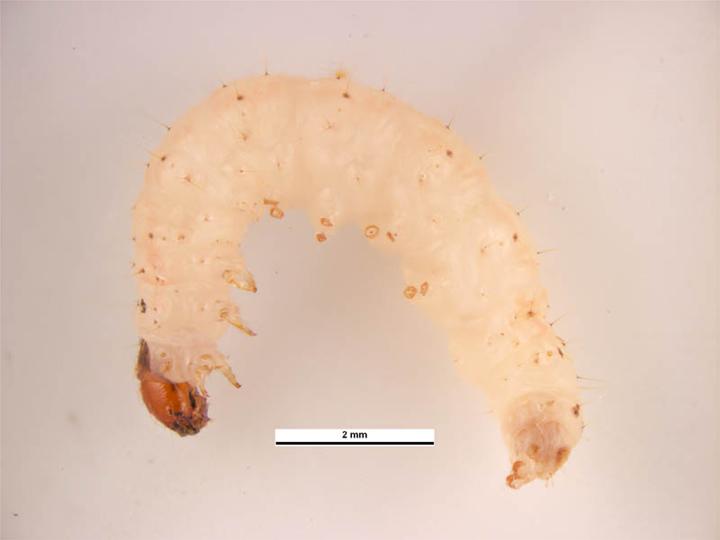Ephestia on:
[Wikipedia]
[Google]
[Amazon]
 ''Ephestia'' is a
''Ephestia'' is a
''Ephestia''.
Fauna Europaea. * '' Ephestia abnormalella'' Ragonot, 1887 * '' Ephestia animella'' K.Nupponen & Junnilainen, 1998 * '' Ephestia callidella'' Guenée, 1845 * '' Ephestia calycoptila'' Meyrick, 1935 * ''
 ''Ephestia'' is a
''Ephestia'' is a genus
Genus ( plural genera ) is a taxonomic rank used in the biological classification of living and fossil organisms as well as viruses. In the hierarchy of biological classification, genus comes above species and below family. In binomial nom ...
of small moths belonging to the family
Family (from la, familia) is a group of people related either by consanguinity (by recognized birth) or affinity (by marriage or other relationship). The purpose of the family is to maintain the well-being of its members and of society. Idea ...
Pyralidae
The Pyralidae, commonly called pyralid moths, snout moths or grass moths, are a family of Lepidoptera in the ditrysian superfamily Pyraloidea. In many (particularly older) classifications, the grass moths (Crambidae) are included in the Pyralida ...
. Some species are significant pests of dry plant produce, such as seed
A seed is an embryonic plant enclosed in a protective outer covering, along with a food reserve. The formation of the seed is a part of the process of reproduction in seed plants, the spermatophytes, including the gymnosperm and angiospe ...
s and cereals. Best known among these are probably the cacao moth (''E. elutella'') and the Mediterranean flour moth (''E. kuehniella'').
The genus ''Cadra
''Cadra'' is a genus of small moths belonging to the family Pyralidae. The genus '' Ephestia'' is closely related to ''Cadra'' and might be its senior synonym. Several of these moths are variously assigned to one or the other genus, in particula ...
'' is closely related to ''Ephestia'' and might be a junior synonym. Several of these moths are variously assigned to one or the other genus, in particular in non-entomological
Entomology () is the scientific study of insects, a branch of zoology. In the past the term "insect" was less specific, and historically the definition of entomology would also include the study of animals in other arthropod groups, such as arach ...
sources.
Diversity
Species
In biology, a species is the basic unit of classification and a taxonomic rank of an organism, as well as a unit of biodiversity. A species is often defined as the largest group of organisms in which any two individuals of the appropriate s ...
of ''Ephestia'' include:Fauna Europaea. * '' Ephestia abnormalella'' Ragonot, 1887 * '' Ephestia animella'' K.Nupponen & Junnilainen, 1998 * '' Ephestia callidella'' Guenée, 1845 * '' Ephestia calycoptila'' Meyrick, 1935 * ''
Ephestia columbiella
''Ephestia columbiella'' is a species of snout moth in the genus ''Ephestia''. It was described by Herbert H. Neunzig in 1990 and is known from North America, including Alabama, Florida, South Carolina and West Virginia
West Virginia is a ...
'' Neunzig, 1990
* '' Ephestia cypriusella'' Roesler, 1965
* '' Ephestia disparella'' Hampson, 1901
* '' Ephestia elutella'' (Hübner, 1796) – cacao moth, tobacco moth, warehouse moth
* '' Ephestia inquietella'' Zerny, 1932
* ''Ephestia kuehniella
The Mediterranean flour moth or mill moth (''Ephestia kuehniella'') is a moth of the family Pyralidae. It is a common pest of cereal grains, especially flour. This moth is found throughout the world, especially in countries with temperate clima ...
'' (Zeller, 1879) – Mediterranean flour moth, Indian flour moth, mill moth
* '' Ephestia laetella'' Rebel, 1907
* '' Ephestia mistralella'' (Millière, 1874)
* ''Ephestia parasitella
''Ephestia parasitella'' is a species of snout moth in the genus ''Ephestia''. It was described by Staudinger in 1859, and is known from Spain, France, the Benelux, Croatia and Russia
Russia (, , ), or the Russian Federation, is a tran ...
'' Staudinger, 1859
* '' Ephestia rectivittella'' Ragonot, 1901
* '' Ephestia subelutellum'' (Ragonot, 1901)
* '' Ephestia unicolorella'' Staudinger, 1881
* '' Ephestia welseriella'' (Zeller, 1848)
References
Phycitini Pyralidae genera {{Phycitini-stub